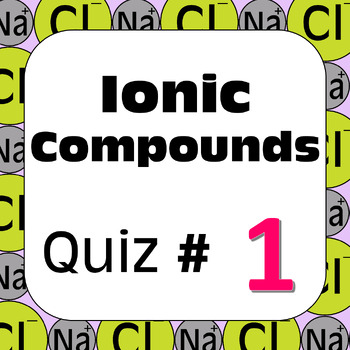Chemical Nomenclature: Ionic Compounds Quiz #1
- PDF
- Easel Activity
- Easel Assessment
Also included in
- The complete bundle of practice worksheets & assessment quizzes for ionic nomenclature mastery! Comprehensive and, with a variety of print & digital resources, it provides plenty of options to choose from depending on your teaching needs. A total of 158 different ionic compounds:All compoundPrice $17.77Original Price $19.75Save $1.98
- The ultimate bundle of practice worksheets and assessment quizzes for chemical nomenclature mastery!Comprehensive and, with a variety of print & digital resources, it provides plenty of options to choose from depending on your teaching needs.550 different compounds.8 practice worksheets (print &Price $60.75Original Price $67.50Save $6.75
Description
Assessment quiz containing 10 different ionic compounds; the first of seven ionic compound quizzes for chemical nomenclature.
Five questions identify the chemical name and require the chemical formula.
Five questions identify the chemical formula and require the chemical name.
- All compounds are binary; composed of two different elements, one metal and one nonmetal (no ternary/polyatomic ions).
- Includes multivalent elements.
- IUPAC-recommended spelling is used.
- All answers included.
This resource includes:
- 1 worksheet (print).
- 1 Easel fillable worksheet (digital).
- 1 Easel multiple-choice activity (digital). ⭐Great for formative assessment.⭐
- 1 Easel multiple-choice assessment (digital). ⭐Great for summative assessment.⭐
Easel activities & assessments are auto-grading with real-time student data. Students may self-check their understanding using these tools.
Click here to follow my store and receive the latest updates.
Original Artwork (©AwesomeScience). For Personal Use Only. Uneditable.
Page count does not include Terms of Use and links to supplementary activities.
Copyright ©AwesomeScience 2013 – The Present.
All Rights Reserved by Author.
By using this Resource you agree to the Terms as outlined in the Terms of Service. This Resource is for limited Personal Use only; not to be used, in part or in whole, for commercial purposes. Each Individual License is for use by one specific educator only. Additional licenses must be purchased for each additional educator. Except as permitted in Section 3 to deliver Resources electronically to Permitted Recipients, you may not post or otherwise make the Resource available on any website, application, shared drive or other sites or services.








